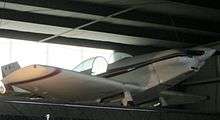Rand Robinson KR-1
The Rand Robinson KR-1 is a single-seat, single-engine sport aircraft designed in the United States in the early 1970s and marketed for homebuilding.[1][2] A two-seat version is marketed as the KR-2.[1][2] It is a low-wing cantilever monoplane of conventional design with an enclosed cockpit and tailwheel undercarriage.[2][3] As originally designed, the main undercarriage units of the KR-1 and basic KR-2 were manually retractable, folding backwards into the wings, while the KR-2T tandem-seat version had fixed undercarriage.[4] However, some builders choose fixed tailwheel or even fixed tricycle undercarriage for KR-1s and KR-2s.[5]
| KR-1 and KR-2 | |
|---|---|
| KR-2S | |
| Role | Homebuilt |
| National origin | United States |
| Manufacturer | nVAero |
| Designer | Kenneth Rand |
| First flight | February 1972 |
| Status | In production (2015) |
Kits for the KR-1, KR-2 and KR-2S are supplied by nVAero of Mission Viejo, California, United States.[6][7]
Design and development
The KR-1's wings have a two-spar construction; the front spar of spruce, and the rear spar from spruce and plywood.[3] The wing ribs are formed from polyurethane foam, and the space around them filled with the same material before the entire wing structure is covered with fabric impregnated with epoxy resin.[3] The fuselage is built around a wooden framework, the lower part skinned in plywood and the upper part built up of polystyrene foam covered in epoxy-coated fabric.[3] KR-1 builders have the choice of three different upper fuselage configurations: the "fastback" with a turtledeck behind the cockpit, the "pursuit" with a fighter-style bubble canopy, and the "sportsman" with an open cockpit and a small fairing behind it for rollover protection.[8]
The design has proved popular, with 6,000 sets of KR-1 plans and 4,500 sets of KR-2 plans sold by 1979.[1] From these, over 200 KR-1s[3] and 350 KR-2s[9] were flying by 1987. Plans and kits were still available in 2011.[10]
Variants

- KR-1 - original, single-seat version
- KR-2 - two-seat, side-by-side version, 1900 completed by 2011.[6]
- KR-2S - stretched version of the KR-2 made with composite sandwich construction, using the supercritical AS5045 airfoil. Standard engines include the 85 hp (63 kW) Jabiru 2200, 120 hp (89 kW) Jabiru 3300 and the 76 to 100 hp (57 to 75 kW) Volkswagen air-cooled engine.[11] 100 completed and flown by 2011.[6]
- KR-2T - tandem version of the KR-2
Aircraft on display
- EAA AirVenture Museum KR-1 N1436[12]
- Queensland Air Museum KR-2 VH-XXS[13]
- Wings Over the Rockies Air and Space Museum KR-1 N60BV[14]
Specifications (typical KR-2)
General characteristics
- Crew: one
- Capacity: one passenger
- Length: 14 ft 6 in (4.42 m)
- Wingspan: 20 ft 8 in (6.30 m)
- Height: 3 ft 6 in (1.07 m)
- Wing area: 80 sq ft (7.4 m2)
- Empty weight: 440 lb (200 kg)
- Gross weight: 800 lb (360 kg)
- Powerplant: 1 × Volkswagen air-cooled engine , 90 hp (67 kW)
Performance
- Maximum speed: 180 mph (290 km/h, 160 kn)
- Service ceiling: 16,000 ft (4,900 m)
- Rate of climb: 800 ft/min (4.1 m/s)
Notes
- Taylor 1989, p.757
- Markowski 1979, p.286
- Jane's All the World's Aircraft 1987–88, p.696
- Jane's All the World's Aircraft 1987–88, p.696–97
- Cox 1995, p.22
- Vandermeullen, Richard: 2012 Kit Aircraft Buyer's Guide, Kitplanes, Volume 28, Number 12, December 2011, page 63. Belvoir Publications. ISSN 0891-1851
- Tacke, Willi; Marino Boric; et al: World Directory of Light Aviation 2015-16, page 120. Flying Pages Europe SARL, 2015. ISSN 1368-485X
- Markowski 1979, p.288
- Jane's All the World's Aircraft 1987–88, p.697
- nVAero website
- Bayerl, Robby; Martin Berkemeier; et al: World Directory of Leisure Aviation 2011-12, page 113. WDLA UK, Lancaster UK, 2011. ISSN 1368-485X
- "Rand Robinson KR-1 - N1436"
- Queensland Air Museum (23 August 2013). "Rand Robinson KR-2 VH-XXS The Beast C/N Q082". Retrieved 22 September 2013.
- Wings Over the Rockies Air and Space Museum. "Aircraft Exhibits". wingsmuseum.org. Archived from the original on 23 October 2018. Retrieved 7 May 2019.
References
- Cox, Jack (September 1995). "A Couple of KR's". Sport Aviation: 22.
- Jane's All the World's Aircraft 1987–88. London: Jane's Publishing.
- Markowski, Michael (1979). The Encyclopedia of Homebuilt Aircraft. Blue Ridge Summit: TAB Books.
- "nVAero website". Retrieved 2011-09-12.
- "Rand Robinson KR-1 - N1436". AirVenture Museum website. Retrieved 2009-01-25.
- Taylor, Michael J. H. (1989). Jane's Encyclopedia of Aviation. London: Studio Editions.